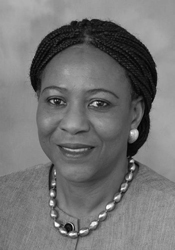Two weeks after glowering, stick-thin models strutted the runways at New York Fashion Week, San Francisco played host to a fashion show of a different kind.
Four women of varying sizes and modes of gender expression glided across a small stage, smiling and laughing as they happily modeled outfits that ranged from a flouncy, lime-green sundress by San Francisco retailer ModCloth to a classic masculine suit and tie, specifically fitted for the curves of a female body, by Oakland-based Saint Harridan.
The appreciative audience made up mostly of women at the Impact Hub San Francisco on Mission Street applauded between sips of wine and signature Campari cocktails.
The occasion was the annual Embody Awards, presented by About-Face, a nonprofit that works in Bay Area schools to improve girls’ self-esteem by challenging society’s unrealistic and unhealthy images of beauty. This year’s celebration came in the form of “Transforming Fashion,” an alternative fashion show to honor four groundbreaking Bay Area designers who are creating “inclusive, body positive” clothes.
“All our honorees are working to change fashion so that true self-expression is available to women and those born female-bodied,” said About-Face Executive Director Jennifer Berger. “We want girls and women to be free, and we want them to think for themselves and to dress as themselves, not someone else.”
The show is yet another sign that media portrayal of women is changing. It follows such recent headline-making moments as Mattel launching a new line of Barbies in different body types and skin tones and Sports Illustrated putting a plus-sized model on its cover.
Taylor Jay, one of the designers honored and a Bay Area native who cut her teeth in wardrobe styling and retail in Los Angeles, now runs a boutique in Oakland’s Laurel district where she creates a line of flowing, feminine dresses, tops and pantsuits that flatter women who wear a range of sizes, from 0 to 2X.
Consider her signature black cardigan wrap. During the show, model Felicia Miracle Cippola demonstrated how the cardigan, which falls below the knees, can be worn in a variety of ways – hanging loose as a sweater over casual pants or wrapped into a Diane von Furstenberg-style cocktail dress.
Jay notes that her customers have jobs, families and busy lives, so they want clothes that are comfortable, versatile and well-made but that also make them feel confident and beautiful.
“You pretty much express who you are through your clothing,” she says. “My customers want to feel comfortable in their own skin.”
Susan Gregg Koger, co-founder and creative director for ModCloth, also creates clothes for a range of sizes, from extra small to 4X.
ModCloth has gained a devoted online following and national media attention for using nonprofessional models, including its own employees, to market its vintage-inspired dresses, swimsuits and other clothes. The retailer has also vowed to never retouch models’ images in Photoshop.
Koger credits style bloggers and social media activists for changing the definition of what’s attractive, including in advertising. “The idea that models have to fit into a narrow definition of beauty to sell clothes is just not true anymore,” she says.
Koger’s model for the show was Julianna Salguero, of San Francisco. Pretty, blonde and curvy, she glided onto the stage in the lime-green sundress and did a twirl to show off its flared skirt and the playful hemline print of dolphins leaping through waves.
Like Jay and Koger, the other designers honored also create clothes that they and their friends love wearing. But Mary Going and Thuy Nguyen’s personal preference for men’s clothing has allowed them to move into a unique market, designing masculine-style custom suits for butch lesbians and transgender men.
Going’s own story illustrates the challenges such women face. In 2008, when California started issuing same-sex marriage licenses, Going wanted to wear a suit at her wedding to partner Martha Rynberg. When she tried men’s stores, she either faced customer service that wasn’t welcoming or she couldn’t find anything that fit properly.
She ended up having a suit custom-made. Measured to fit her shoulders, breasts, hips and 5-foot, 3-inch frame, the suit filled her with confidence and left her thinking “this is how clothing should feel on me.”
Her hunch that other lesbians and transgender men would appreciate that feeling has paid off. To launch Saint Harridan in 2012, she netted $137,000 in prepurchased garments through Kickstarter. She’s also opened pop-up stores in 15 U.S. cities and in September opened a flagship store in Oakland, Calif., for custom fittings.
While it may be nontraditional to design men’s suits for women, Going’s designs are anything but. At the show, model Cal Light playfully vogued across the stage in one of Going’s sleek but classic black wool suits. “From the beginning, we were really going for a traditional men’s design,” Going said.
Nguyen, who fled with her family from Vietnam in 1975 and was raised in San Jose, creates for her Thuy Custom Clothier designs that are more “edgy.”
Some of her well-tailored men’s items are infused with feminine elements, a nod to the influence of her parents. Her mother, for one, was a master tailor of traditional “ao dai” Vietnamese dresses.
“Growing up around the constant humming of my mother’s sewing machine and a father who was a sharp dresser was my experience (in forming) my style and fashion sensibility,” she says.
At the show, model Koko Shishida wore Nguyen’s “Esther” suit, with its fitted gray jacket over a billowing white blouse and leg-baring trouser shorts.
Like the other designers, Nguyen says the Bay Area is a good place to be creating designs outside mainstream sensibilities. One side project is to help parents get their gender-fluid children affordable prom suits.
“Last year, I lent out suits for prom at no cost,” she says. That’s something she can’t see doing in many other places. “We’re in a bubble in the Bay Area,” she notes, “but in a good way.”


